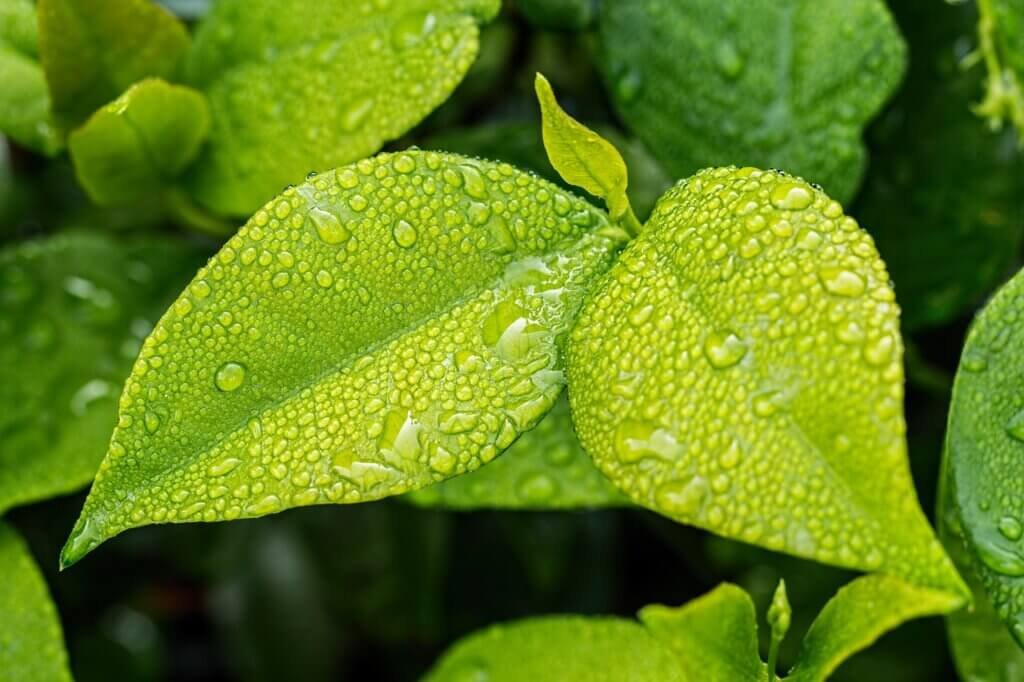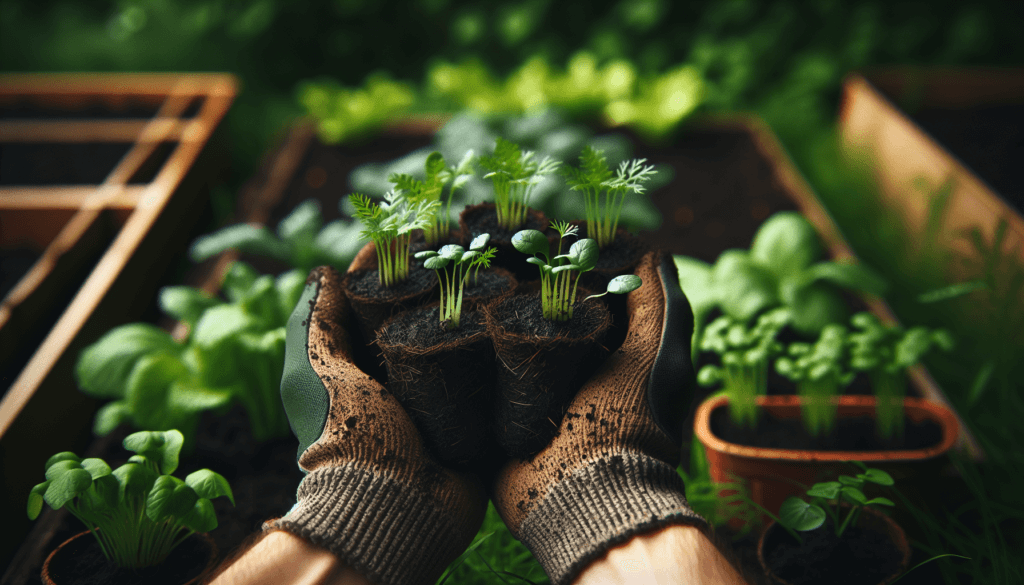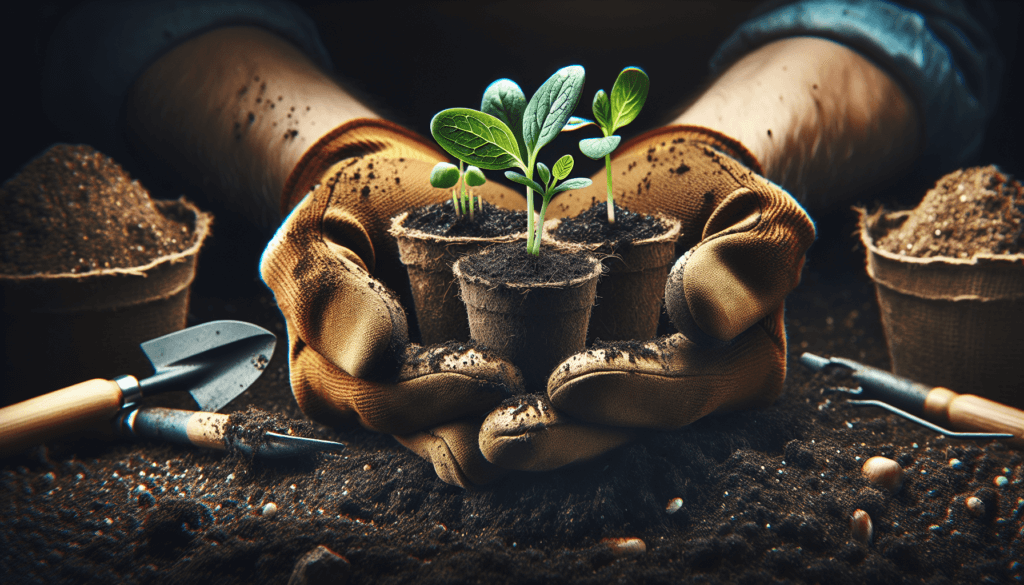If you’ve ever dreamed of growing your own delicious and nutritious vegetables, but have no idea where to begin, then look no further! This article will guide you through the essential steps on how to start a vegetable garden from scratch. Whether you have a small backyard or just a few pots on a balcony, this friendly guide will provide you with all the tips and tricks you need to turn your green thumb dreams into a fruitful reality. Get ready to dig in and discover the joy and satisfaction of cultivating your very own home-grown vegetables!

Choosing the Right Location
Consider the Sunlight
When choosing a location for your vegetable garden, one of the most important factors to consider is sunlight. Vegetables generally require at least six hours of direct sunlight each day to thrive. Observe your outdoor space throughout the day to determine which areas receive the most sunlight. Avoid shaded areas or spots that are mostly in the shadow of trees or buildings. Choosing a sunny location will help ensure the success of your vegetable garden.
Evaluate the Soil
The quality of the soil in your chosen location is another crucial aspect to consider. Take a look at the soil composition and texture. Ideally, you want well-draining soil that is rich in organic matter. Assessing the pH level of the soil is also important, as different vegetables thrive in different pH ranges. You may consider conducting a soil test to determine the pH level and make any necessary adjustments. Evaluating the soil beforehand will help you make informed decisions about which vegetables will flourish in your garden.
Check for Drainage
Good drainage is essential for a healthy vegetable garden. Excess waterlogged soil can cause root rot and drown plants. Before you begin planting, check for proper drainage in your chosen location. If you notice standing water after heavy rainfall, it may indicate poor drainage. Consider installing drainage systems or raised beds to prevent waterlogging. Checking for adequate drainage will ensure the long-term success of your vegetable garden.
Planning and Designing the Garden
Determine the Garden Size
Determining the size of your vegetable garden is an important step in the planning process. Consider the available space and the amount of time and effort you are willing to invest in maintenance. If you’re a beginner, it’s advisable to start with a smaller garden that you can easily manage. As you gain more experience and confidence, you can always expand your garden. Starting with a manageable garden size will help you avoid feeling overwhelmed and ensure a more enjoyable gardening experience.
Layout and Bed Design
Once you’ve determined the size of your garden, it’s time to plan the layout and bed design. Consider the accessibility of your garden beds, making sure there is enough space to comfortably move around and tend to your plants. Raised beds are popular for vegetable gardens as they provide better soil drainage and prevent soil compaction. Plan the layout in a way that maximizes sunlight exposure for each bed. Take into account any existing structures, such as fences or walls, and design your garden beds accordingly.
Consider Companion Planting
Companion planting is a strategy that involves planting mutually beneficial crops together. Certain plants can help repel pests, attract beneficial insects, or provide shade and support for others. Research different companion plants that complement each other and plan your garden accordingly. For example, planting marigolds alongside tomatoes can help deter pests, while growing bush beans near corn can provide natural support. Consider companion planting to create a more biodiverse and productive vegetable garden.
Preparing the Soil
Clear the Area
Before you start preparing the soil, it’s essential to clear the area of any debris, weeds, or grass. Remove rocks, large roots, and any other objects that may hinder the growth of your plants. Clearing the area will provide a clean slate for your vegetable garden and prevent competition for nutrients and space.
Test the Soil
Testing the soil is a crucial step in preparing your vegetable garden. A soil test will help determine the nutrient content and pH level of the soil, allowing you to make informed decisions about soil amendments. Many local agricultural extension offices offer soil testing services, or you can purchase a DIY soil testing kit. Testing the soil will ensure that your plants have the necessary nutrients to grow and thrive.
Amend the Soil
Based on the results of your soil test, you may need to amend the soil to create optimal growing conditions for your vegetables. Organic matter, such as compost, well-rotted manure, or peat moss, can help improve soil structure and nutrient content. Add the necessary amendments to the soil and mix them thoroughly to ensure even distribution. Amending the soil will provide a nutrient-rich environment for your plants and promote healthy growth.
Selecting the Vegetables
Consider Climate and Season
When selecting vegetables for your garden, it’s important to consider your local climate and the current season. Different vegetables thrive in different climatic conditions, so choose those that are well-suited to your region. Determine if your area experiences hot summers, cold winters, or other specific weather patterns. Additionally, consider the specific season in which you are starting your garden, as some vegetables are better suited for spring or fall planting.
Assess Space and Time
Consider the available space in your garden and assess how much time you can dedicate to gardening. Some vegetables, like sprawling pumpkin or cucumber plants, require ample space to grow and spread. Other vegetables, like lettuce or radishes, can be grown in smaller spaces or even containers. Assessing space and time will help you make informed decisions about which vegetables to choose and how many plants to grow.
Choose Vegetables for Beginners
If you’re new to vegetable gardening, it’s advisable to start with vegetables that are relatively easy to grow. Some beginner-friendly options include tomatoes, cucumbers, lettuce, radishes, and herbs like basil and parsley. These vegetables are generally forgiving and require minimal maintenance. Starting with vegetables for beginners will increase your chances of success and give you the confidence to explore more challenging crops in the future.

Starting from Seeds or Seedlings
Understanding Seed Types
When starting a vegetable garden, you have the option of starting from seeds or purchasing seedlings. Understanding the different seed types is important to make an informed decision. Some plants, like carrots and beans, are typically direct-seeded since they do not transplant well. Others, like tomatoes or peppers, are often started indoors as seedlings before transplanting. Consider the specific requirements of each vegetable and choose the most suitable method for starting your plants.
Starting Seeds Indoors
Starting seeds indoors allows you to get a head start on the growing season and gives you control over the germination process. You will need seed trays or pots, seed-starting soil mix, and proper lighting to provide an ideal environment for seed germination. Follow the instructions on the seed packets for specific planting depths and care requirements. Starting seeds indoors will give you a greater variety of vegetable options and ensure more successful germination.
Purchasing Seedlings
If you prefer to skip the seed-starting process, you can purchase seedlings from local nurseries or garden centers. This option is convenient if you have limited time or resources for starting seeds indoors. When purchasing seedlings, choose healthy, robust plants with no signs of disease or pests. Transplant the seedlings into your prepared garden beds following the proper planting guidelines. Purchasing seedlings allows you to jump-start your vegetable garden without the initial hassle of starting seeds.
Planting and Transplanting
Follow Seed Packet Instructions
When planting seeds or transplanting seedlings, it’s crucial to follow the instructions provided on the seed packets. Pay attention to recommended planting depths, spacing requirements, and any specific care instructions. Different vegetables have different needs, and following the guidelines on the seed packets will help ensure successful growth and development.
Preparing the Soil for Transplants
If you are transplanting seedlings, prepare the soil in your garden beds beforehand. Gently loosen the soil and create a hole slightly larger than the root ball of the seedling. Carefully remove the seedling from its pot, being mindful not to disturb the roots. Place the seedling in the hole, ensuring that it is planted at the same depth it was in the pot. Backfill the hole with soil, firm it gently around the seedling, and water thoroughly. Properly preparing the soil will promote healthy root development and help the seedlings thrive in their new environment.
Transplanting Seedlings Properly
When transplanting seedlings, it’s important to handle them with care to minimize transplant shock. Water the seedlings a few hours before transplanting to ensure they are well-hydrated. Gently remove the seedlings from their containers, being careful not to damage the roots. Plant them at the appropriate spacing, following the recommended guidelines for each vegetable. Avoid disturbing the roots as much as possible. After transplanting, water the seedlings thoroughly to settle the soil and help them establish in their new environment.

Watering and Fertilizing
Establishing a Watering Routine
Proper watering is essential for the health and growth of your vegetable garden. Establishing a watering routine will help ensure your plants receive the adequate moisture they need. Water deeply and evenly, making sure to reach the root zone of the plants. Avoid excessive or shallow watering, as it can lead to poor root development and increased vulnerability to pests and diseases. Consider using a soaker hose or drip irrigation system to deliver water directly to the plant roots and minimize water loss through evaporation.
Providing Proper Drainage
While watering is crucial, it’s equally important to provide proper drainage for your vegetable garden. Excess water should be able to drain away, preventing waterlogging and root rot. If your garden has poor natural drainage, consider raised beds or incorporating organic matter into the soil to improve drainage. Adequate drainage will help maintain a healthy balance of moisture in the soil and prevent water-related issues.
Choosing Organic Fertilizers
Fertilizing your vegetable garden will provide the essential nutrients necessary for optimal plant growth and production. When selecting fertilizers, consider using organic options to promote a more sustainable and environmentally-friendly garden. Organic fertilizers, such as compost, manure, or bone meal, contribute to soil health and provide a slow-release source of nutrients. Apply fertilizers according to the specific needs of each vegetable and follow the recommended dosage instructions. Choosing organic fertilizers will help you grow healthy, nutritious vegetables without the use of harmful chemicals.
Weeding and Mulching
Identify and Remove Weeds
Weeds can compete with your vegetables for nutrients, water, and space, hindering their growth and productivity. Regularly inspect your vegetable garden for weeds and promptly remove them. Identify common weeds in your area and learn to differentiate them from your desired plants. Pull weeds by hand or use a garden tool, ensuring you remove the roots as well. Regular weeding will help maintain a clean and weed-free environment for your vegetables to thrive.
Applying Mulch
Mulching is an effective technique for suppressing weeds, conserving moisture, and regulating soil temperature. Apply a layer of organic mulch around your vegetable plants once they have established. Suitable options include straw, wood chips, or shredded leaves. Ensure the mulch is applied evenly and is not in direct contact with the plant stems or leaves. Mulching will help reduce weed growth, retain soil moisture, and create a more favorable environment for your vegetables.
Types of Mulch to Use
When choosing a mulch for your vegetable garden, consider the specific needs of each plant and the prevailing climate in your area. Organic mulches like straw or wood chips are commonly used in vegetable gardens. They slowly break down over time, enriching the soil with organic matter. Black plastic or landscape fabric can also be used as a mulch to warm the soil and control weeds. Research the best mulch options for the vegetables you are growing to promote healthy growth and minimize maintenance.

Pest and Disease Control
Preventative Measures
Preventing pests and diseases from infesting your vegetable garden is key to maintaining healthy plants. Implementing preventative measures will help reduce the risk of future problems. Start by selecting disease-resistant varieties of vegetables whenever possible. Avoid overcrowding plants, as it can lead to increased moisture and humidity, creating favorable conditions for diseases. Regularly sanitize your gardening tools and equipment to prevent the spread of pathogens. Taking preventative measures will minimize the need for interventions later on.
Organic Pest Control Methods
If pests do become a problem in your vegetable garden, there are several organic pest control methods you can use. Introduce beneficial insects, like ladybugs or lacewings, to help control aphids and other pests. Use organic insecticidal soaps or horticultural oils to target specific pests while minimizing harm to beneficial insects. Employ physical barriers, such as row covers or netting, to prevent pests from reaching your plants. Organic pest control methods reduce the need for chemical pesticides and promote a healthier ecosystem in your garden.
Identifying Common Pests and Diseases
Familiarize yourself with common pests and diseases that can affect your vegetable garden. Some common pests include aphids, caterpillars, slugs, and snails. These pests can cause significant damage to your plants if not addressed promptly. Diseases such as powdery mildew, blight, and root rot can also affect vegetable plants. Learn to identify the symptoms of pests and diseases early on to implement appropriate control measures. Regular monitoring and timely intervention are essential for preventing widespread damage to your vegetable garden.
Maintaining and Harvesting
Regular Monitoring and Maintenance
To ensure your vegetable garden thrives, regular monitoring and maintenance are necessary. Inspect your plants for signs of nutrient deficiencies, pest infestations, or diseases. Check the soil moisture levels and adjust your watering routine accordingly. Prune any dead or damaged plant parts to promote healthy growth. Remove spent flowers to encourage continuous production. Regular monitoring and maintenance will help you address issues promptly and maintain a healthy and productive vegetable garden.
Pruning and Support Systems
Certain vegetables, like tomatoes or cucumbers, benefit from pruning and support systems. Pruning involves removing suckers or excess branches to focus the plant’s energy on fruit production. Use clean pruning shears and follow proper pruning techniques to prevent damage to the plants. Additionally, providing support systems such as trellises or stakes helps keep the plants upright and improves air circulation. Pruning and support systems promote healthier plants, higher yields, and easier harvesting.
Harvesting Vegetables at the Right Time
Harvesting your vegetables at the right time is crucial to ensure optimal flavor and quality. Different vegetables have different signs of readiness for harvesting. For example, tomatoes are usually harvested when they are fully colored and slightly soft to the touch, while lettuce should be harvested when the leaves are young and tender. Refer to the specific instructions on the seed packets or do some research to learn the ideal harvesting time for each vegetable. Harvesting at the right time will reward you with delicious and nutritious produce from your vegetable garden.
Starting a vegetable garden from scratch may seem like a daunting task, but with careful planning and proper execution, it can be a rewarding and enjoyable experience. By considering factors such as sunlight, soil quality, and drainage, you can choose the perfect location for your garden. Planning the garden size, layout, and bed design, as well as considering companion planting, will help maximize the productivity of your vegetables.
Preparing the soil by clearing the area, testing and amending the soil, ensures a nutrient-rich environment for your plants to thrive. Selecting the right vegetables based on climate, space, and your experience level is crucial for successful gardening. You can choose to start from seeds or purchase seedlings, depending on your preference and the requirements of each vegetable.
Proper planting and transplanting techniques, along with watering routines and organic fertilizers, contribute to healthy plant growth. Managing weeds through timely identification and removal, as well as applying the right mulch to suppress weed growth, helps maintain a clean and low-maintenance garden. Implementing preventative measures, using organic pest control methods, and timely identification of common pests and diseases contribute to a healthy and thriving vegetable garden.
Regular monitoring, maintenance, pruning, and use of support systems ensure the ongoing health of your garden. Harvesting vegetables at the right time guarantees the best taste and quality. By following these comprehensive steps and tips, you can start and maintain a successful vegetable garden from scratch. Enjoy the process and the bountiful harvest that awaits you!



